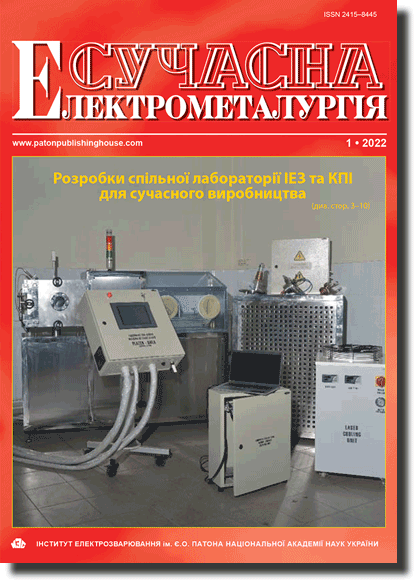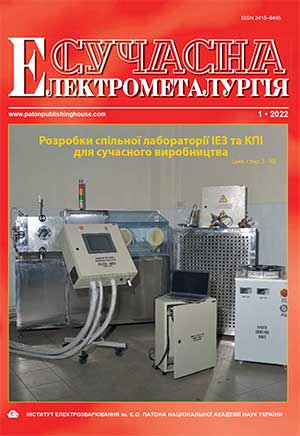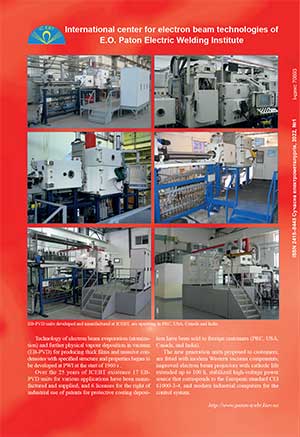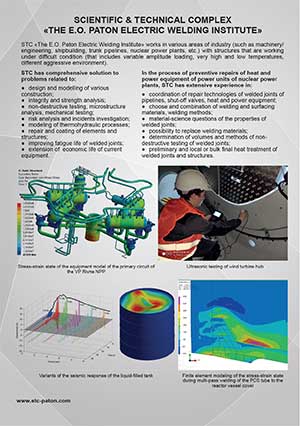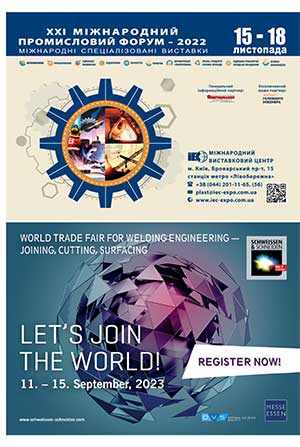| 2022 №01 (05) |
DOI of Article 10.37434/sem2022.01.06 |
2022 №01 (07) |
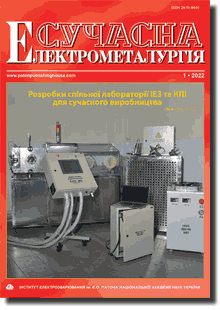
"Suchasna Elektrometallurgiya" (Electrometallurgy Today), 2022, #1, 47-55 pages
Structure and properties of welded joints of steel 20 modified by nanoparticles of tungsten carbide
V.Yu. Bilous, V.V. Pashynskyi, V.O. Berezos, R.V. Selyn, E.L. Vrzhyzhevskyi
E.O. Paton Electric Welding Institute of the NAS of Ukraine. 11 Kazymyr Malevych Str., Kyiv, 03150, Ukraine. E-mail: office@paton.kiev.ua
Abstract
The work is devoted to study of the influence of process parameters of welding steel 20 on the structure and properties of low carbon steel welded joints. Experimental steel was modified by nanosized carbide modifier of the system of «thermally split graphite (TRG)–wolframite». The aim of the study was to establish the details of formation of the structure and complex of mechanical properties in the material, containing dispersed reinforcing particles of the carbide phase under the thermal influence of welding processes. The steel was obtained by the method of electron beam remelting (EBR) of the charge billet, which included a nanoscale carbide modifier. Welding of experimental steel samples was performed using electron beam welding (EBW) and argon-arc welding (AAW) technologies. The obtained samples were used to study the macro- and microstructure of the base metal and welded joints by optical microscopy, as well as to determine the mechanical characteristics of metal of welded joints. It was found that the base metal, produced by EBR and following hot rolling of the obtained ingot has a homogeneous ferritic-pearlitic structure, but the morphology of the carbide phase in eutectoid colonies differs from plate pearlitic morphology due to the presence of spheroidized carbide phase particles. In welding by AAW technology, structures with the morphology of the same type as in the base metal are formed in the HAZ, the main difference is the increase in the degree of carbide phase spheroidization and some increase in grain size. EBW technology leads to formation of narrow layers with the structure of lath martensite in the weld fusion zone. It has been established that both the welding technologies provide joints with mechanical characteristics on the level of the base metal, but the EBW technology ensures higher ductility characteristics of the metal. Ref. 13, Table. 4, Fig. 7.
Keywords: nanoscale modifier; tungsten carbide; dispersion hardening; electron beam welding; argon arc welding; strength; elongation; microstructure
Received 24.01.2022
References
1. Ayan Bhowmik, Wengang Zhai, Wei Zhou, Sharon Mui Ling Na (2021) Characterization of carbide particle-reinforced 316L stainless steel fabricated by selective laser melting. Mater. Characterization, 179, 111360. https://doi.org/10.1016/j.matchar.2021.1113602. Liang, J.W., Shen, Y.F., Misra, R.D.K. Liaw, P.K. (2021) High strength-superplasticity combination of ultrafine-grained ferritic steel: The significant role of nanoscale carbides. J. of Mater. Sci. & Technology, 83, 131-144. https://doi.org/10.1016/j.jmst.2020.11.078
3. Huabing Yang, Tong Gao, Huaning Zhang et al. (2019) Enhanced age-hardening behavior in Al-Cu alloys induced by in-situ synthesized TiC nanoparticles. J. of Mater. Sci. & Technology, 35(3), 374-382. https://doi.org/10.1016/j.jmst.2018.09.029
4. Jiao, Z.B., Luan, J.H., Guo, W. et al. (2016) Effects of welding and post-weld heat treatments on nanoscale precipitation and mechanical properties of an ultra-high strength steel hardened by NiAl and Cu nanoparticles. Acta Materialia, 120, 216-227. https://doi.org/10.1016/j.actamat.2016.08.066
5. Pereira, V.S.M., Davisc, T.P., Mayoral, M.H. et al. (2022) Investigation of coarsening of oxide nanoparticles at 1400 K and its effect on the microstructure formation of an ODS Eurofer steel. Mater. Characterization, 185, 111723. https://doi.org/10.1016/j.matchar.2022.111723
6. Akhonin, S.V., Berezos, V.O., Severin, A.Yu. et al. (2020) Producing be electron beam melting the ingots of iron alloyed with silicon carbide. Suchasna Elektrometal., 3, 24-29. https://doi.org/10.37434/sem2020.03.03
7. Węglowskia, M.St., Błachaa, S., Phillips, A. (2016) Electron beam welding: Techniques and trends. Review. Vacuum, 130, 72-92. https://doi.org/10.1016/j.vacuum.2016.05.004
8. Raghawendra, P.S. Sisodia, Marcell Gaspar. (2021) Experimental assessment of microstructure and mechanical properties of electron beam welded S960M high strength structural steel. Manufacturing Letters, 29, 108-112. https://doi.org/10.1016/j.mfglet.2021.05.004
9. Zamkov, V.N., Velikoivanenko, E.A., Sabokar, V.K., Vrzhizhevsky, E.L. (2005) Selection of preheating temperature of titanium γ-aluminide in EBW. In: TITAN: Technologies. Equipment. Production. Kiev, PWI, 20-23 [in Russian].
10. Kah, P. (2021) Advancements in intelligent gas metal arc welding systems. Fundamentals and applications. Woodhead Publishing Series in Welding and Other Joining Technologies, 1-103. https://doi.org/10.1016/B978-0-12-823905-6.00001-5
11. Akhonin, S.V., Belous, V.Yu. (2017) Argon-arc welding of titanium and its alloys with application of fluxes. The Paton Welding J., 2, 8-14. https://doi.org/10.15407/as2017.02.02
12. Guseva, E.A., Klimychev, A.I. (1997) Complete penetration argon-arc welding of titanium alloys. Svarochn. Proizvodstvo, 2, 15-16 [in Russian].
13. Fuyang Gao, Yongjie Cui, Yifan Li et al. (2021) Microstructure and properties of Ti-6Al-4V alloy welded joint by keyhole gas tungsten arc welding. Mater. Sci. and Engineering: A, 827. https://doi.org/10.1016/j.msea.2021.142024
Advertising in this issue:
The cost of subscription/purchase order journals or individual articles
| Journal/Currency | Annual Set | 1 issue printed |
1 issue |
one article |
| TPWJ/USD | 384 $ | 32 $ | 26 $ | 13 $ |
| TPWJ/EUR | 348 € | 29 € | 24 € | 12 € |
| TPWJ/UAH | 7200 UAH | 600 UAH | 600 UAH | 280 UAH |
| AS/UAH | 1800 UAH | 300 UAH | 300 UAH | 150 UAH |
| AS/USD | 192 $ | 32 $ | 26 $ | 13 $ |
| AS/EUR | 180 € | 30 € | 25 € | 12 € |
| SEM/UAH | 1200 UAH | 300 UAH | 300 UAH | 150 UAH |
| SEM/USD | 128 $ | 32 $ | 26 $ | 13 $ |
| SEM/EUR | 120 € | 30 € | 25 € | 12 € |
| TDNK/UAH | 1200 UAH | 300 UAH | 300 UAH | 150 UAH |
| TDNK/USD | 128 $ | 32 $ | 26 $ | 13 $ |
| TDNK/EUR | 120 € | 30 € | 25 € | 15 € |
AS = «Automatic Welding» - 6 issues per year;
TPWJ = «PATON WELDING JOURNAL» - 12 issues per year;
SEM = «Electrometallurgy Today» - 4 issues per year;
TDNK = «Technical Diagnostics and Non-Destructive Testing» - 4 issues per year.





